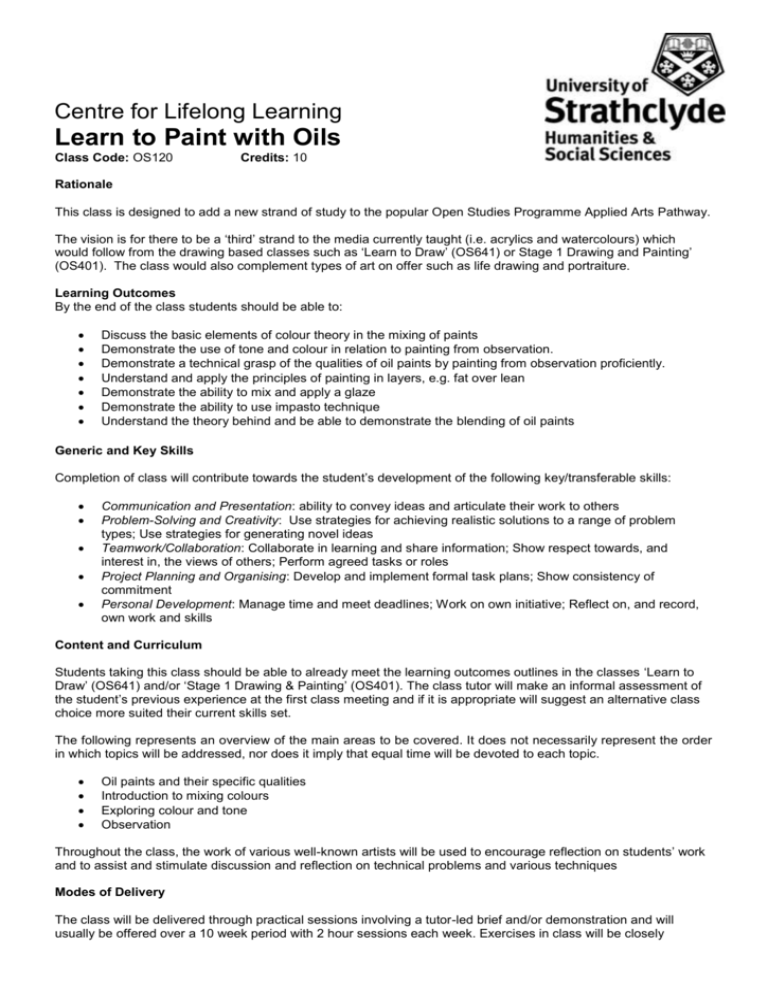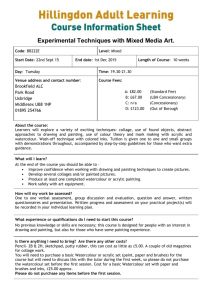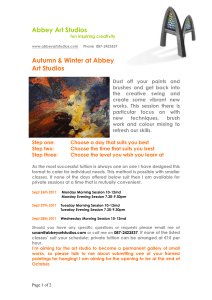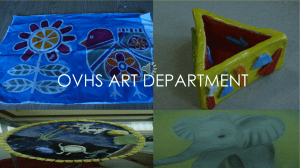Learn to Paint using Oils (OS120) Student Handout 2015
advertisement

Centre for Lifelong Learning Learn to Paint with Oils Class Code: OS120 Credits: 10 Rationale This class is designed to add a new strand of study to the popular Open Studies Programme Applied Arts Pathway. The vision is for there to be a ‘third’ strand to the media currently taught (i.e. acrylics and watercolours) which would follow from the drawing based classes such as ‘Learn to Draw’ (OS641) or Stage 1 Drawing and Painting’ (OS401). The class would also complement types of art on offer such as life drawing and portraiture. Learning Outcomes By the end of the class students should be able to: Discuss the basic elements of colour theory in the mixing of paints Demonstrate the use of tone and colour in relation to painting from observation. Demonstrate a technical grasp of the qualities of oil paints by painting from observation proficiently. Understand and apply the principles of painting in layers, e.g. fat over lean Demonstrate the ability to mix and apply a glaze Demonstrate the ability to use impasto technique Understand the theory behind and be able to demonstrate the blending of oil paints Generic and Key Skills Completion of class will contribute towards the student’s development of the following key/transferable skills: Communication and Presentation: ability to convey ideas and articulate their work to others Problem-Solving and Creativity: Use strategies for achieving realistic solutions to a range of problem types; Use strategies for generating novel ideas Teamwork/Collaboration: Collaborate in learning and share information; Show respect towards, and interest in, the views of others; Perform agreed tasks or roles Project Planning and Organising: Develop and implement formal task plans; Show consistency of commitment Personal Development: Manage time and meet deadlines; Work on own initiative; Reflect on, and record, own work and skills Content and Curriculum Students taking this class should be able to already meet the learning outcomes outlines in the classes ‘Learn to Draw’ (OS641) and/or ‘Stage 1 Drawing & Painting’ (OS401). The class tutor will make an informal assessment of the student’s previous experience at the first class meeting and if it is appropriate will suggest an alternative class choice more suited their current skills set. The following represents an overview of the main areas to be covered. It does not necessarily represent the order in which topics will be addressed, nor does it imply that equal time will be devoted to each topic. Oil paints and their specific qualities Introduction to mixing colours Exploring colour and tone Observation Throughout the class, the work of various well-known artists will be used to encourage reflection on students’ work and to assist and stimulate discussion and reflection on technical problems and various techniques Modes of Delivery The class will be delivered through practical sessions involving a tutor-led brief and/or demonstration and will usually be offered over a 10 week period with 2 hour sessions each week. Exercises in class will be closely supervised and guided by the tutor. There will be group discussion of individual work to prepare students for peer assessment in later classes.. There will also be scope for revision according to the needs of students as they present drawing projects. There will be group discussion of an example of each individual’s work. Assessment There are three elements to the assessment: A. 2 colour exercises completed in class (one to be discussed by the class as a group) (20%) B. 1 painting of a still life subject completed in class demonstrating use of techniques and skills learnt in class (40%) C. 1 landscape or figure painting completed in class demonstrating some skill in mixing colours (40%) All elements of assessment must be submitted and deemed satisfactory by the tutor before the student can be recommended for the award of credit. A sample of work will be second marked prior to scrutiny by the Open Studies External Examiner. Class Materials Students are responsible for the purchase of their own materials and a list of materials suggested by the tutor will be supplied prior to the first class meeting. References Suggested book and web references include: _ Wilcox, M (2002) Blue and Yellow Don’t Make Green (Bristol: Michael Wilcox) Bill Creevy (1999) The Oil Painting Book: Materials and Techniques for Today's Artist (Watson-Guptill Materials and Techniques) Jeremy Galton (2001) The Encyclopedia of Oil PaintingTechniques: A Unique Step-by- Step Visual Directory of All the Key Oil Painting Techniques http://www.artisancam.org.uk/home.php http://www.getty.edu/education/ http://www.nsead.org/home/index.aspx Tutor The tutor for Learn to Paint with Oils (OS120) is Saul Robertson BA











